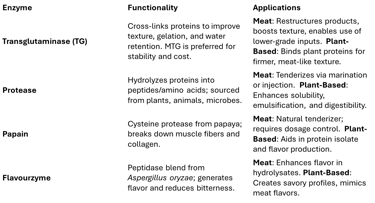
Enzymes in Meat and Plant Protein Processing
The applications of a few key enzymes use in animal meat and plant protein processing and quality improvement are summarized
3 min read
Proteases
Proteases are enzymes that catalyze the hydrolysis of peptide bonds and are foundational to both traditional and modern food processing. Their versatility spans meat tenderization, flavor development, protein modification, and even clean-label innovation.
🥩 Meat Industry Applications
Tenderization: Proteases break down muscle proteins and connective tissue, improving texture and palatability.
Flavor Enhancement: Controlled hydrolysis releases peptides and amino acids that contribute to umami and savory notes, especially in broths, bouillons, and meat snacks.
Restructured Meats: Proteases help modify protein networks for better binding and texture in sausages, nuggets, and deli-style products.
🌱 Plant-Based & Functional Foods
Protein Hydrolysates: Applied to soy, pea, wheat, and other plant proteins to improve solubility, reduce bitterness, and enhance emulsification.
Alt-Meat Texture Optimization: Proteases soften plant proteins and enable meat-like textures without synthetic binders such as methylcellulose.
Digestibility & Nutrient Release: Enzymatic hydrolysis improves bioavailability and supports gut-friendly claims.
🧀 Dairy & Fermented Foods
Cheese Production: Proteases coagulate milk proteins for curd formation.
Flavor Development: Proteolysis during aging contributes to complex flavor profiles in aged cheeses and fermented dairy.
Flavourzyme
Flavourzyme is a versatile proteolytic enzyme blend derived from Aspergillus oryzae, known for its unique combination of endo- and exo-peptidase activities. It’s a powerhouse for flavor development and debittering in protein-rich food systems, especially relevant to clean-label and functional ingredient goals.
🥩 Applications in Meat Processing
Protein Hydrolysates: Used to break down meat proteins into peptides and amino acids, enhancing umami and reducing bitterness
Flavor Generation: Ideal for savory bases, bouillons, and meat extracts
Debittering: Removes harsh notes from partially hydrolyzed proteins, improving palatability in restructured meats and snacks
🌱 Applications in Plant-Based & Functional Foods
Alt-Protein Enhancement: Applied to soy, pea, or wheat proteins to create clean-label flavor systems with reduced bitterness and improved mouthfeel
Savory Snacks & Bars: Enables soft texture and rich taste in high-protein formats like nutrition bars
Hydrolyzed Vegetable Protein (HVP): Generates glutamate-rich profiles for natural flavoring without MSG
Transglutaminase
Transglutaminase (TGase), often dubbed “meat glue,” is a microbial enzyme that catalyzes covalent cross-linking between proteins, specifically between glutamine and lysine residues. Its ability to restructure and enhance protein matrices makes it a game-changer across meat, dairy, and plant-based food systems.
🥩 Applications in Meat Processing
Restructured Meats: Binds smaller cuts or trimmings into cohesive, whole-muscle-style products, ideal for clean-label deli meats and portion control
Texture Enhancement: Improves bite, juiciness, and elasticity in sausages, nuggets, and patties
Water-Holding Capacity: Reduces cooking loss and shrinkage, boosting yield and sensory appeal
Fat Reduction: Cross-linked proteins can mimic fat texture, enabling low-fat formulations without compromising mouthfeel
🐟 Seafood Applications
Gel Strengthening: Enhances gel formation in surimi and fish cakes, especially from frozen or low-quality raw materials
Moisture Retention: Improves freeze-thaw stability and reduces syneresis
🥛 Dairy Applications
Cheese Yield & Texture: Cross-links casein and whey proteins to improve curd firmness and reduce whey loss
Yogurt & Milk Protein Gels: Enables low-fat, high-protein textures with better stability and shelf life
Edible Coatings: Modified milk proteins can serve as natural packaging or barrier films
🌱 Plant-Based & Functional Foods
Soy & Pulse Proteins: Enhances solubility, emulsification, and gelation—ideal for alt-meat and dairy analogs
Protein Fortification: Stabilizes high-protein snacks and beverages without phase separation
Clean-Label Structuring: Enables meat-like textures without synthetic binders such as methylcellulose, work well with laccase
Papain
Papain is often referred to as “plant pepsin” and a proteolytic enzyme derived from Carica papaya that’s widely used in meat and food processing for its ability to hydrolyze proteins efficiently. Here's how it plays out across different applications:
🥩 Meat Industry Applications
Tenderization: Papain breaks down tough muscle fibers and connective tissue proteins (especially collagen), making lower-grade cuts more palatable. It’s particularly effective in the pH range of 5.5–6.0 and at temperatures around 50–60°C.
Flavor Enhancement: At higher concentrations, papain hydrolyzes meat and fish proteins to produce savory flavor bases for soups, sauces, and seasonings.
Restructuring Meat: Used to improve texture and digestibility in restructured meat products, such as sausages or jerky.
🌾 Plant-Based & Functional Foods
Protein Hydrolysis: Applied to soy, wheat, peas, and pulses to reduce viscosity and create hypoallergenic or functional proteins, ideal for clean-label formulations.
Flavor Development: Generates peptides and amino acids that mimic meat or dairy flavors, supporting salt reduction and umami enhancement.
🐾 Animal Feed & Pet Food
Enhances protein digestibility and flavor in pet foods
Used in poultry feed to improve nutrient absorption and forage ensiling
While many food scientists continue to focus on chemical additives for preservation, texture, and flavor enhancement, they may not fully realize the transformative potential of enzymes in food processing. Enzymes offer targeted, clean-label solutions that can restructure proteins, enhance digestibility, and unlock natural flavor profiles—especially in meat, plant-based proteins, and dairy systems. Unlike broad-spectrum chemical additives, enzymes operate with substrate specificity and can be fine-tuned for desired outcomes, from tenderizing meat and reducing bitterness in plant proteins to improving lactose tolerance and texture in dairy.
The following enzymes offer valuable tools for enhancing the functionality and sensory properties of both traditional meat, dairy and innovative plant-based meat alternatives. They enable the creation of products with improved texture, tenderness, and flavor, in a sustainable, and label-friendly way. Most enzymes are non-GMO, vegan-friendly, and suitable for kosher and halal products.



